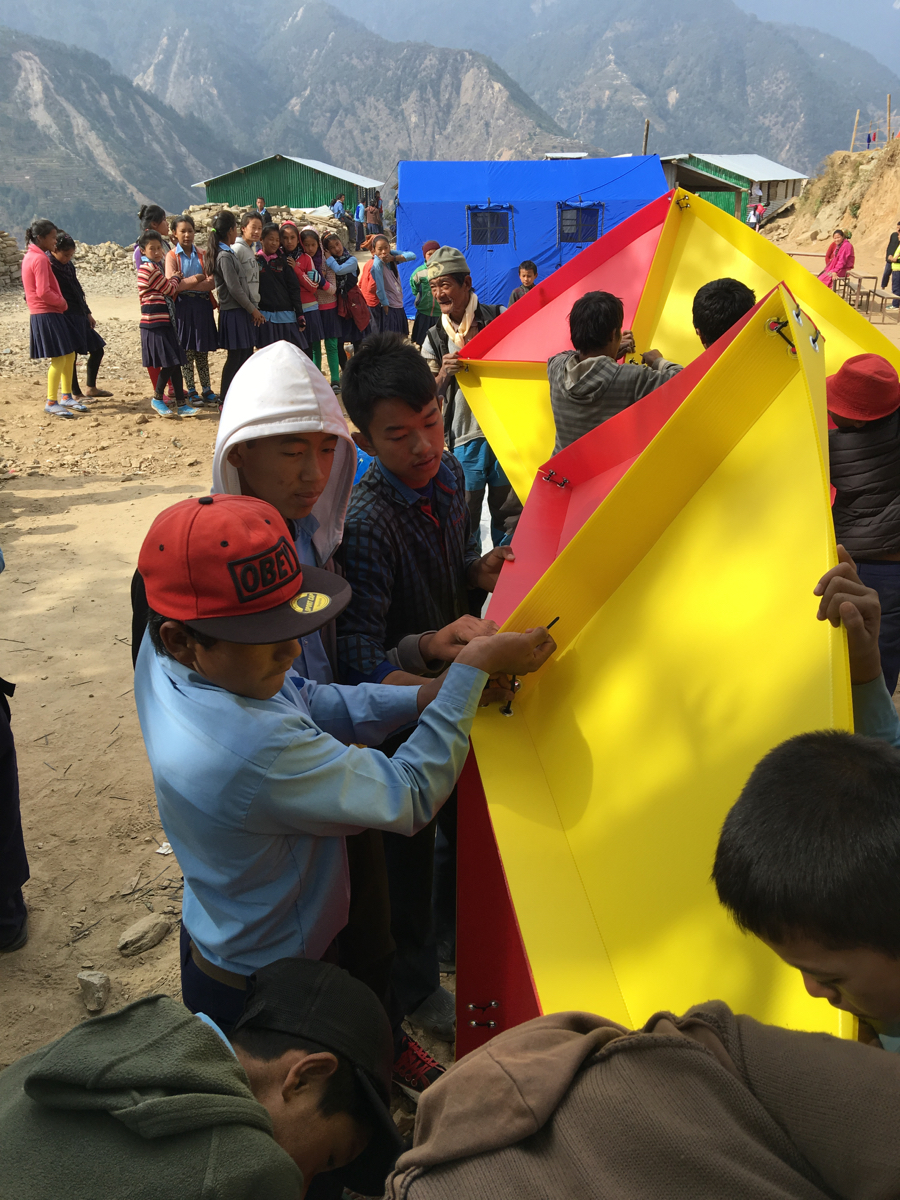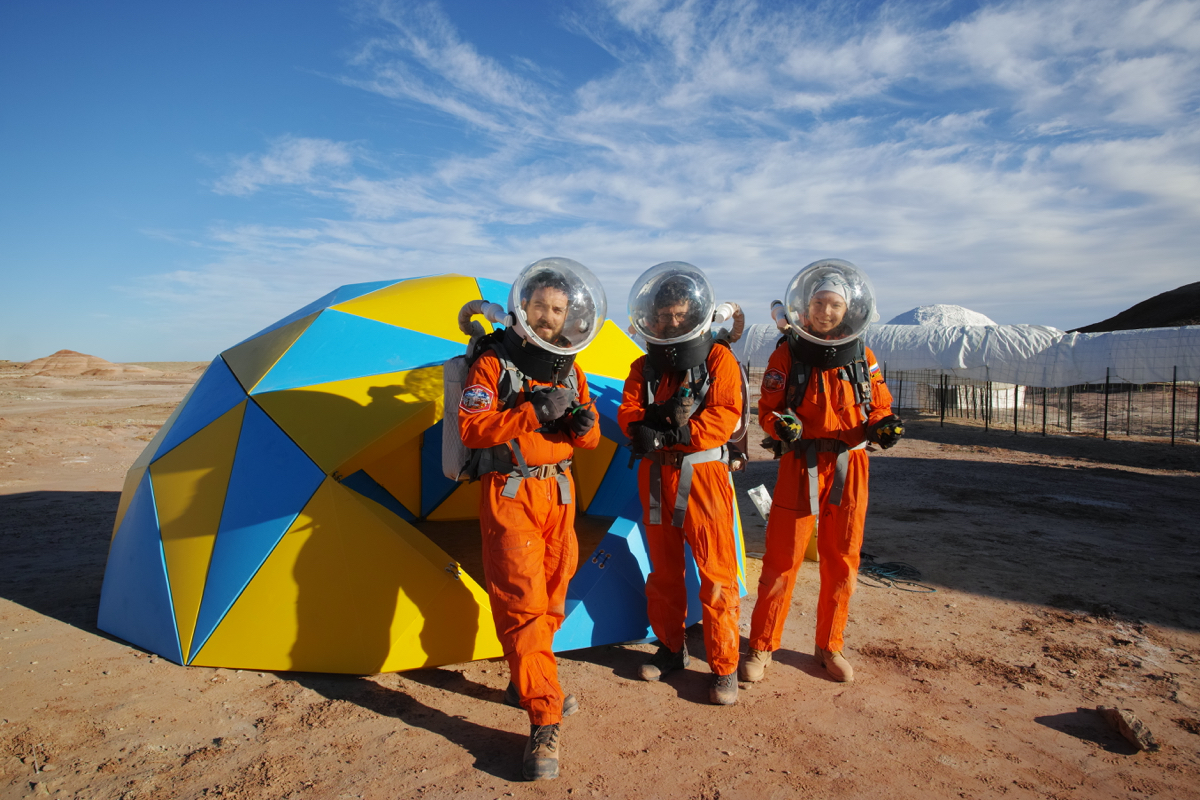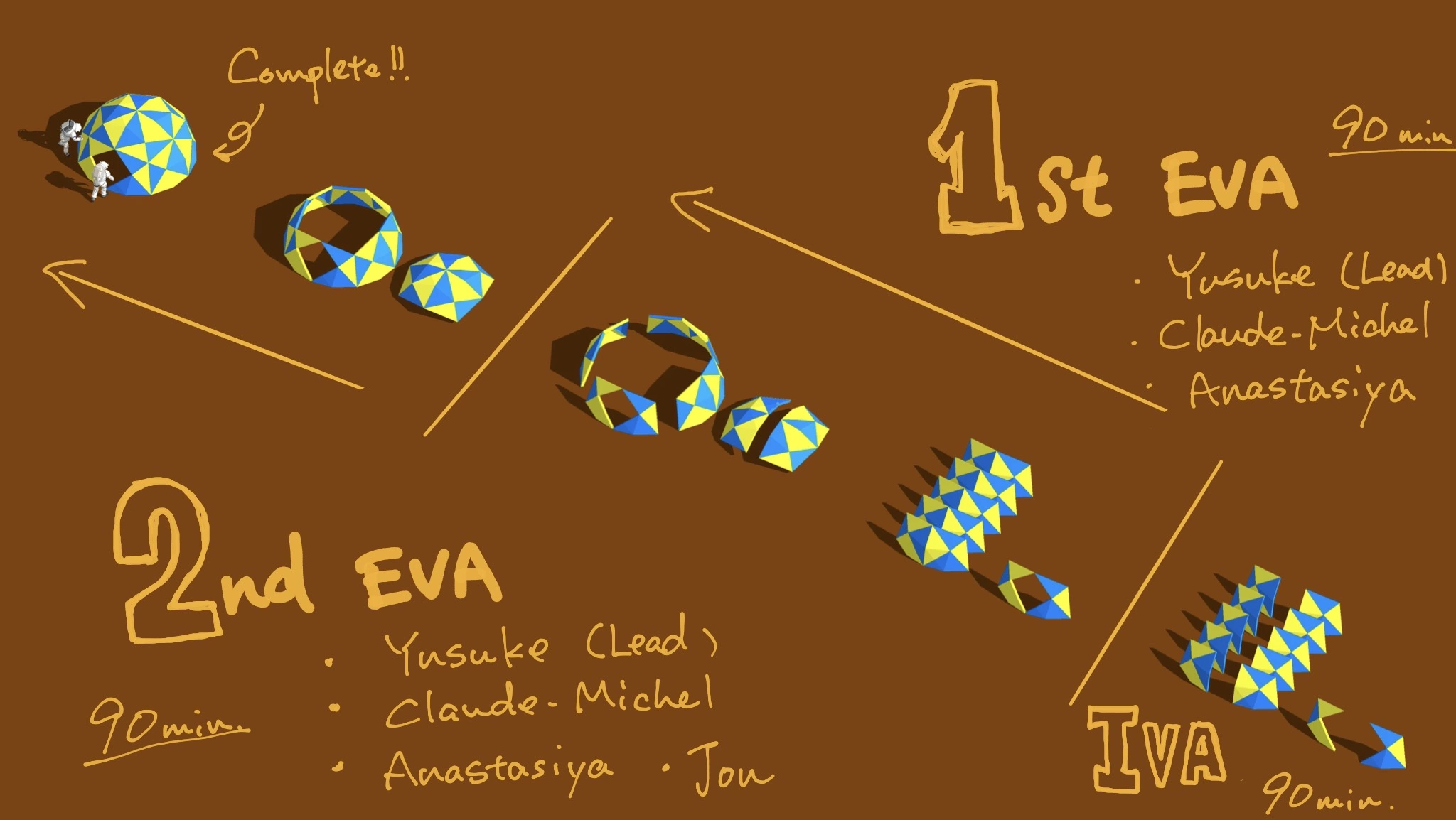What connection does art - a seemingly aesthetic and intellectual pursuit - have with space exploration? These Red Planet researchers offer us a new perspective on the significance of art in future space missions.
Back when the word ‘masks’ conjured up images of decadent masquerade balls and gloves were meant to be donned in winter, The Mars Society organised the Mars 160 Twin Desert-Arctic Analogue Mission - a field exploration program conducted in the Mars Desert Research Station in Utah and the Flashline Mars Arctic Research Station in Canada. The overarching aim of this program was to follow a multi-national crew of seven as they spent eighty days at each location, testing technologies and field exploration strategies in conditions similar to those of the Red Planet.
 Mars 160 crew members (Courtesy: The Mars Society)
Mars 160 crew members (Courtesy: The Mars Society)
Among this group of dedicated and highly experienced individuals was Annalea Beattie, an artist and educator based out of Melbourne. The director of the National Space Society of Australia, her studies of art revolve around understanding its importance in the societies that will be created outside the confines of Earth. As space travel grows more and more ubiquitous, it becomes vital to understand how isolation and harsh conditions affect the quality of life, and deploying art will help humanity swiftly adapt to these new environments. Speaking at The Institutions of Extraterrestrial Liberty, a series of webinars hosted by the University of Edinburgh in 2021, Beattie emphasizes this by observing, “Art keeps our will to imagine alive. It offers us both immediacy and slow contemplation through the material and the sensory. It habitually encourages us to perform, to be curious, to improvise, and to take risks. It stimulates us to courageously and critically explore other realities and modes of resistance. Through art, we can fail or dissent, we can reinvent ourselves.”
The epitome of a polymath, Leonardo da Vinci, once said,
“The painter has the Universe in his mind and hands.”
Through drawing, we can better understand the objects that surround us. For example, one of the most important weapons in an artist’s arsenal is the ability to paint a still life. In order to create a life-like image, the artist has to be intimately acquainted with the sources of light, how they fall on the objects, and how they interact with each other to create interesting shadows and textures. A portrait artist gradually becomes familiar with every wrinkle on their subject’s face, how their lips curve when they’re happy, and how their eyes droop when they’re sad.
Drawing upon (pardon the pun) this knowledge, Beattie performed studies to understand how field drawing could help future astronauts better observe their surroundings and reinforce understanding of their experiences. Through the act of physical sketching, field artists are forced to prioritise what they intuit to be of more importance, effectively de-emphasizing irrelevant features. They contemplate and actively seek to understand important phenomena, finding ideas and potential hitherto unexplored. Of course, photography has its merits, but this results in an information overload where geologists who later study these images simply do not know where to look. It is a disengaged process that leaves a lot to chance. On the other hand, to draw, we have to first seek, and this process uncovers relationships, details, and context to the information gathered that is simply invaluable.
 Drawing of ripples in a modern dry creek bed (Courtesy: The Mars Society)
Drawing of ripples in a modern dry creek bed (Courtesy: The Mars Society)
Beattie also compared the effectiveness of sketching normally to sketching with a spacesuit on. The footage of floating astronauts from the Apollo era would remind us that spacesuits are bulky and cumbersome, so it was a point of curiosity for Beattie to understand how an intricate process like drawing would be affected by these sartorial constraints. She sums up her findings by saying,
“The results of field drawing research in and out of simulation are consistent. Overall, in relation to quantity of output and time constraints, productivity in drawing decreases by one fifth when wearing the spacesuit. All evidence indicates field drawing in the spacesuit to be a little slower and there is less comfort drawing in the suit but this is a manageable factor. Experiments show that the quality of the suited drawing itself is marginally less, for instance, in clarity of line or expression, but this does not impede meaning. Importantly, research concludes that whether field drawing is undertaken in or out of the spacesuit, the science return in terms of the data is basically the same. This is significant when we think about astronaut training for Mars. With the right materials, tools and protocols, extraterrestrial geologists will be able to draw and take notes in science fieldwork on Mars, just like they do here on Earth.”
 Drawing lichens (Courtesy: The Mars Society)
Drawing lichens (Courtesy: The Mars Society)
Another member of this expedition, Yusuke Murakami, is a Japanese architect who has been christened by Beattie as a human extremophile. Extremophiles are organisms that live in what we would consider to be comparatively ‘extreme’ conditions, such as hydrothermal vents and the ocean floor. When we inevitably colonise the rest of the solar system, our future generations would also be extremophiles to the ones left behind on Earth. Murakami earned this moniker by going on an eclectic bunch of travels to places like Antarctica and Mt. Everest.
Murakami’s main role in Mars 160 was to understand the inventory of food by measuring the food requirements of the crew in eighty-day batches. He also spearheaded the cultivation of fresh food resources in the Arctic half of the simulation. According to him, the study of extremity (climatic, not political) on Earth is valuable because even though we have a general idea of the conditions that the Martian environment embodies, there will still be unpredictable challenges to groups living in poisonous and heavily surveilled habitats, cut off from the rest of humankind. Studying organisms living in these types of conditions could also help us speculate what forms extraterrestrial organisms living in similar circumstances could take.
 Biologist at work (Courtesy: The Mars Society)
Biologist at work (Courtesy: The Mars Society)
The primary research undertaken by Murakami on this mission has to do with a project he conceived of beforehand, The Dome Project. Combining his architectural roots with his passion for life in harsh climates, this endeavour began in 2015 after a series of earthquakes ravaged Nepal. He had previously created a prototype of a dome for a classroom project, which he then took to Nepal to see if it could be used to provide shelter. Through interacting with the people who would ultimately use his design, he was able to refine it and went back to Japan to obtain the resources to make what he now calls ‘earthquake shelters’.
 Schoolkids constructing the dome (Courtesy: The Mars Society)
Schoolkids constructing the dome (Courtesy: The Mars Society)
This experience made him a fierce proponent of human-centric design, something researchers often fail to consider when designing space stations. The focus is often on the form of the stations alone, rather than how astronauts would be able to work in them in the conditions of outer space. While assembling these domes in the Mars 160 mission, Murakami compared the process with and without the bulk of the spacesuits, akin to what Beattie did with the field drawing process. He came to the conclusion that the suit acted as a sort of universal equalizer, forcing astronauts to assemble technology in identical ways. Through observing these interactions, he was able to make certain key observations on how people wearing space suits interact in harsh environments, something that will help him design extraterrestrial spaces in the future.
 (Courtesy: The Mars Society)
(Courtesy: The Mars Society)
Summarising his research goals, he says,
“In Japan, the tatami mat is a measure of human-sized physical space in the house. We can say that how people worked to assemble the dome is a measure of human-sized process, as a kind of a space tatami, a module for the future, as a baseline for designing a Mars station in space.”
Murakami’s dome is called the Dare Demo Dome, which means ‘a dome for everyone’ in Japanese.
 Dare Demo Dome construction plan (Courtesy: The Mars Society)
Dare Demo Dome construction plan (Courtesy: The Mars Society)
Kurt Vonnegut once said,
“We have to continually be jumping off cliffs and developing our wings on the way down.”
As we young adults gradually inherit a planet where problems keep creeping up like the Hydra’s regenerating heads, we will need creative people, the modern-day versions of Hercules, who will take the plunge and go off to build these cosmic colonies, thinking up on-the-spot solutions to the issues they face on their way.
Creating these societies also offers us an opportunity to reinvent what it means to live as a community and conjure new definitions of life. Integrating art will help us understand democracy and create new methods of self-governance and democratic principles. From the days of cave paintings that catalogued livestock to minting NFTs, humankind has used art to represent, to understand, and to invent. Math may be the language of science, but art is the language of living, and it is up to us to use this common language to redefine life in outer space.
References:
- Notes from Mars 160: Why Field Drawing Is Important to Mars Exploration
- Notes from Mars 160: The Space Architecture of Yusuke Murakami
- Mars Society homepage
- The Institutions of Extraterrestrial Liberty (Day 4)
Edited by Aniket Kukreti
